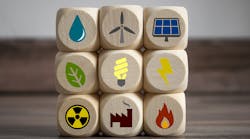Jabil's Greenhouse-Gas-Slashing Plan: Good Data, Equipment Upgrades, In-House Energy Production
As the planet warms up, corporations are feeling the heat from consumers and governments alike to reduce their greenhouse gas emissions, from both company sources (Scope 1) and purchased electricity (Scope 2). At Jabil, a global manufacturer and Fortune 200 company, Scope 2 emissions currently make up approximately 97% of our total emissions inventory and we are focused on reducing our carbon footprint at each of our sites. As we progress in our journey to measure emissions outside our company—but tied to our suppliers and business activities like transportation and distribution—(Scope 3), we expect Scope 3 will become the largest category.
One tactic some companies have adopted to offset their Scope 1 and Scope 2 emissions is purchasing renewable energy certificates or credits (RECs), known as guarantees of origin (GOs) in Europe. Each certificate is worth a certain number of megawatt hours and certifies that power was generated from a renewable source like hydro, wind or solar. On paper, this strategy can help an organization move toward carbon neutrality. In reality, it can mask their true emissions inventory.
Through the purchase of these certificates, clean energy is actually produced, and it is verifiable through common sustainability reporting. However, the purchase has little impact on the company’s actual emissions. For example, a company in Massachusetts could buy a REC and be credited with energy generated on a wind farm in New Mexico. This strategy is an expensive way of reducing your emissions on paper while still using traditional forms of power.
To make a true impact on the environment, we need to think differently about how we reduce greenhouse gas emissions at our own facilities.
There is a Better Way: Emissions Inventory Management
At Jabil, I lead the global energy team, but our entire company is focused on reducing our carbon footprint. Our climate action plan outlines a four-pronged approach to emissions reduction — manage, reduce, produce and procure — that will not only reap sustainability benefits but also yield return on investment for our organization and our customers. We’ve already seen the plan’s potential; Jabil achieved a 19% greenhouse gas reduction in 2021 compared to 2020, putting us well on our way to meeting our goal of a 25% reduction by 2025 and a 50% reduction by 2050.
The first step in our plan to reduce Scope 1 and Scope 2 emissions is managing our current emissions inventory. In this phase, the source and amount of emissions are identified within our factories and facilities. Automation plays an increasingly important role in the tools we use to manage emissions information. We are in the process of automating data collection from energy and utility bills to eliminate the possibility of human error from manual entry, while building management systems (BMS) use historical data, weather information, energy costs and other information to monitor and detect patterns in the energy usage of a particular production line or machine.
Another tool to help monitor and manage energy usage is electronic control modules (ECMs). When placed on equipment from lights to compressors, the ECMs can tell operations managers how much electricity the equipment is using at high-demand times, its temperature and more to determine whether is it pulling too much electricity.
Managing energy usage gives us the information we need to move to the second step of our emissions reduction plan — reducing our energy consumption. At Jabil, approximately 35% to 50% of our energy usage occurs on the production floor, stemming from high-intensity equipment like injection molding machines and compressors. Other large electricity draws include chillers, paint fans, pumps and ventilation.
Reducing the energy use of crucial capital equipment usually means replacing them or upgrading them to be more efficient. For example, take compressors. These machines can, alone, account for 15% to 30% of a manufacturing site’s total energy use, depending on the site’s profile. We’ve found that adding a variable speed drive, which varies the amount of air pushed out of the compressor to make sure that it’s only pushing out air when driving a process, drove down the entire site’s energy consumption by about 30%.
Water-cooled chillers are another potential area for energy savings. Like most technologies, they have become both less expensive and more efficient over time. By year 14 or 15 of their 18-year life expectancy, chillers typically begin drawing more energy than they require to function. Chillers account for approximately 20% of a site’s energy use, but my team has determined that simply replacing aging equipment with more updated options could cut total energy consumption by 15% to 30%.
By reducing energy use across your manufacturing facility, your Scope 2 emissions will likely begin to decline. So, likely, will your energy bills.
Going Green: Producing and Procuring Green Energy
After first identifying where we can reduce energy usage and taking measures to do so, the third step of Jabil’s four-pronged emissions reduction strategy is produce. We are in the early stages of generating green energy at some of our sites for our own use. For example, our Clinton, Massachusetts, site will soon install rooftop solar panels, which will offset around 15% of the site’s greenhouse gas emissions. We are also building solar in China, India, Mexico and across our European facilities.
Considering the large footprint of most Jabil sites, generating enough solar energy at our own facilities to become completely carbon neutral would be a challenge. Imagine a roof 10 miles long lined with solar panels — the feasibility is not exactly there.
While we’re engaging in as many on-site green energy projects as possible wherever we can, we have also included a fourth step in our strategy: procure. We are entering direct power purchase agreements (PPAs) with local utilities to receive power at our facilities that was produced through solar, wind or hydro generation. These agreements allow us to use electricity where and how we need it at our sites but have assurance it was created both locally and through environmentally conscious means.
By the time we reach these third and fourth steps of our process, the goal is to have eliminated as much of our energy consumption, especially of non-renewable brown power, as possible in the first two steps. While this is certainly a solid strategy from an emissions reduction perspective, it’s important to remember that sustainability is good for business: Making processes and equipment more efficient makes buying green energy, whether through PPAs or RECs, less expensive. There’s simply less power to procure if a manufacturing site now needs less electricity to run.
Organizational decarbonization is an investment, but it should be looked at as an opportunity, not a hindrance to success. By uncovering how your operations are most significantly contributing to greenhouse gas emissions and finding innovative ways to lessen their impacts, you can begin to realize wins on both your ESG reports and your balance sheets.
PJ Farrenkopf is project manager for Global Energy, Jabil.




